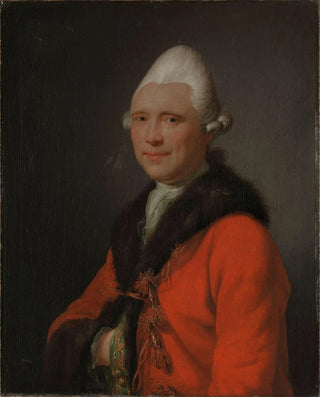Art print | Otto Christopher von Munthe de Morgenstierne - Jens Juel


View from behind

Frame (optional)
Otto Christopher von Munthe de Morgenstierne - Jens Juel Art print – Engaging introduction
In the fascinating world of art, some works transcend their era to become timeless witnesses to the human condition. The Otto Christopher von Munthe de Morgenstierne - Jens Juel art print is a striking example. It not only highlights the technical virtuosity of its creator but also the rich and complex history surrounding its subject. This piece, through its penetrating gaze and atmosphere charged with meaning, invites the viewer to delve into a profound reflection on identity and the passage of time. Contemplating this painting, one is immediately transported into a universe where every detail tells a story, where light and shadow intertwine to give life to universal emotions.
Style and uniqueness of the work
Jens Juel's style, a Danish painter of the 18th century, is characterized by a realistic and intimate approach, where characters are often depicted with great psychological finesse. In this work, the posture of the subject, their expression, and even the nuances of their clothing reflect meticulous observation and a deep understanding of human nature. The color palette, subtly chosen, unfolds harmoniously, creating a balance between warm and cool tones that evoke both softness and melancholy. Juel manages to capture not only the physical appearance of his model but also an essence, an atmosphere that resonates deeply with the viewer. Every brushstroke seems charged with emotion, transforming a simple representation into a true exploration of the human soul.
The artist and his influence
Jens Juel, an emblematic figure of Danish art, played a crucial role in the development of portraiture in the 18th century. Trained at the Royal Danish Academy of Fine Arts in Copenhagen, he mastered the blend of tradition and innovation, drawing inspiration from European masters while cultivating a distinctive style recognizable as his own. His influence extends beyond his time, as his works continue to inspire many contemporary artists. By emphasizing the psychology of his subjects, Juel paved the way for a more introspective approach to portraiture, marking a significant evolution in the art of portrait.

Matte finish

View from behind

Frame (optional)
Otto Christopher von Munthe de Morgenstierne - Jens Juel Art print – Engaging introduction
In the fascinating world of art, some works transcend their era to become timeless witnesses to the human condition. The Otto Christopher von Munthe de Morgenstierne - Jens Juel art print is a striking example. It not only highlights the technical virtuosity of its creator but also the rich and complex history surrounding its subject. This piece, through its penetrating gaze and atmosphere charged with meaning, invites the viewer to delve into a profound reflection on identity and the passage of time. Contemplating this painting, one is immediately transported into a universe where every detail tells a story, where light and shadow intertwine to give life to universal emotions.
Style and uniqueness of the work
Jens Juel's style, a Danish painter of the 18th century, is characterized by a realistic and intimate approach, where characters are often depicted with great psychological finesse. In this work, the posture of the subject, their expression, and even the nuances of their clothing reflect meticulous observation and a deep understanding of human nature. The color palette, subtly chosen, unfolds harmoniously, creating a balance between warm and cool tones that evoke both softness and melancholy. Juel manages to capture not only the physical appearance of his model but also an essence, an atmosphere that resonates deeply with the viewer. Every brushstroke seems charged with emotion, transforming a simple representation into a true exploration of the human soul.
The artist and his influence
Jens Juel, an emblematic figure of Danish art, played a crucial role in the development of portraiture in the 18th century. Trained at the Royal Danish Academy of Fine Arts in Copenhagen, he mastered the blend of tradition and innovation, drawing inspiration from European masters while cultivating a distinctive style recognizable as his own. His influence extends beyond his time, as his works continue to inspire many contemporary artists. By emphasizing the psychology of his subjects, Juel paved the way for a more introspective approach to portraiture, marking a significant evolution in the art of portrait.






